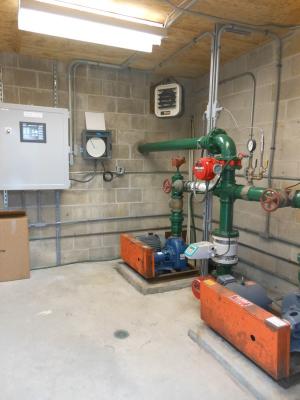Tidewater completes Plantations improvements
Tidewater Environmental Services Inc. has completed nearly $500,000 worth of updates and improvements to the wastewater treatment facility for Plantations and Plantations East developments, off Plantation Road near Lewes.
The company began providing wastewater service to the two communities after purchasing the system Oct. 1, 2013.
As part of the approval process, Delaware Public Service Commission and the Delaware Department of Natural Resources and Environmental Control required capital improvements so the system would comply with state water-pollution regulations.
Jeff Deats, Tidewater Utilities statewide production manager, said the company thoroughly evaluated the system shortly after the purchase, finding the bones of the system were in good working order.
Deats said because there had been relatively no maintenance done to the system, the major concern was the condition of the lift pumps that move the waste from the communities to the holding lagoon. He said the company who installed the system had done a good job, and they were in good working order.
The process to treat the wastewater is the same process the county uses; said Deats during a tour of the facility Nov. 25.
The wastewater is pumped into a holding lagoon, which is full of naturally occurring microorganisms that feed on the waste. Oxygen is pumped into the lagoon, he said, to keep the organisms alive.
The water is then pumped into two other holding lagoons where it sits until it’s disinfected further through a chlorine contact tank. Following this, 40 industrial sprinklers spray the water onto a 20-acre hay field on the western edge of the property. Deats said the species of hay was specifically chosen because it likes the phosphorus and nitrogen found in the treated water.
Deats said the water sprayed onto the field is not harmful to humans and the levels of contaminants is well below DNREC required levels. He said as a safeguard, samples of groundwater are taken from nine 20-foot wells found around the property on a quarterly basis.
Deats said the biggest investment made was installating a computer system, known in the industry as a PLC, that allows for automated operation of several systems. Before the computer's installation, Deats said, tubes feeding oxygen into the lagoon ran 24 hours a day, which was unnecessary. Now, they run for 15 minutes on and then 15 minutes off, cutting running time in half.
The computer also allows setting the sprinklers on a timer. Deats said before the new system, an employee would have to make three trips to the pumphouse a day to turn the system on, make sure it's running at the right pressure, and then to turn it off. The new computer allows monitoring with only one trip per day, said Deats.
Additional improvements include a new pumphouse roof, new spray pumps, the re-tilling and replanting of the spray field, the rebuilding of the spray system, the residing of the aeration building, the construction of a new generator building with three new generators, general site cleaning/removal of rubbish pile, life rings between lagoons, chemical room addition.
Chris Flood has been working for the Cape Gazette since early 2014. He currently covers Rehoboth Beach and Henlopen Acres, but has also covered Dewey Beach and the state government. He covers environmental stories, business stories and random stories on subjects he finds interesting, and he also writes a column called Choppin’ Wood that runs every other week. He’s a graduate of the University of Maine and the Landing School of Boat Building & Design.




























































